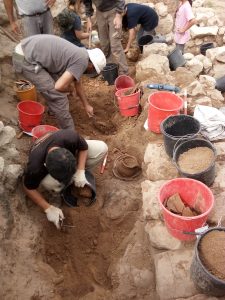
After four years of excavation in Khirbet a-Ra‘i, near Kiryat Gat, an international team of archaeologists has identified the site as Ziklag, a Philistine settlement where – according to the book of Samuel – David was garrisoned with his followers and their families in the last days of King Saul’s reign. (As a fugitive pursued in his homeland, David took refuge among his own people’s bitter enemies, under the patronage of Achish king of Gat.) Some of the excavated remains typify Philistine culture, while others characterize the Israelite kingdom under David in the late 11th and early 10th centuries BCE.
Prof. Yossi Garfinkel of the Hebrew University and Saar Ganor of the Israel Antiquities Authority helped identify Khirbet Qeiyafa, near Beth Shemesh, with the biblical city of Shaaraim, which they claim guarded the border dividing David’s kingdom from Philistine territory. Together with Drs. Kyle Keimer and Gil Davis of Macquarie University, in Sydney, these archaeologists now suggest that Khirbet a-Ra‘i marked the western border of David’s kingdom.
The ceramics found onsite reflect Philistine earthenware from the 12th and 11th centuries BCE, after which there was a shift to pots decorated with a red glaze associated with the ancient Israelites. There’s also a destruction layer, reflecting the trauma that put the town’s last residents to flight. All these discoveries match the biblical description of David’s dwelling in Ziklag, returning after battle to find it destroyed and its women and children captured by roaming desert raiders – the Amalekites. But is this textual support enough to confirm the site’s identity?
Many archaeologists doubt it. “Completely impossible,” declared Prof. Gershon Galil of the University of Haifa, pointing out that the book of Joshua twice places Ziklag in the territory of Simeon, farther south. Galil suggests an alternative location: Tel Sera, situated between Netivot and the Bedouin town of Rahat.
Nevertheless, this latest testimony to the power of David’s kingdom offers further evidence of an Israelite conquest – however temporary – of a Philistine settlement in the 10th century BCE.


